|
O'Kelley Coat of Arms
I doubt my family used a Coat of
Arms, but if we did, it would have
been the O'Kelley of Bregia Arms
because it predated the O'Kelly of
Hy-many arms by 500 years or more.
Bregia Arms uses the wealth of Ireland, a
garb of barley as is center and not
a stone tower house of a family at
war with England.
Food was everything in that time and
those without food were poor, one
needed food to be a powerful family
to feed its defenders.
Author and family historian
Alethea Jane Macon
-6, who descends from
Sarah
Josephine Tuck -5,
Louisa Disey
O'Kelley -4,
James O'Kelley
-3, Charles Dean
O'Kelley -2, James and Elizabeth
O'Kelley -1, William
O'Kelley displayed the
O'Kelly of
Hy-Many Coat of Arms
on the right inside cover of her 1969 book
titled "Four O'Kelley Sons and Some of their
Descendants"
and
some of my ancestors have associated the traditional
and registered
O'Kelly of
Hy-Many Coat of Arms with my family maybe as far
back as 1880s when Professor Thomas Dean O'Kelley
-5, who descends from
Dr Francis C.
O'Kelley -4,
Thomas Dean
O'Kelly -3,
Francis O'Kelley -2,
William and Elizabeth O'Kelley -1,
James O'Kelley
visited Ireland and brought it back from Ireland. I find
it doubtful that the traditional
O'Kelly of
Hy-Many Coat of Arms
was ever used by my Irish family mostly because "Stone Tower Houses"
like the one that appears on the
O'Kelly of
Hy-Many Coat of Arms
didn't come into use in Ireland
until the 15th century and the
English Invasion of 1172 AD reduced
the O'Kelleys in Co Fermanagh
and Northern Bregia
so low that they almost
disappeared
from Irish History so it seems certain that my Irish family may have
never used this arms which likely
didn't exist before 1400AD but there was a
William O'Kelley who may have
been my ancestor living in Dublin in
1597 who registered this arms as his
own so this is difficult to know for
certain. I pointed out that
Macon's arms above right she used "O'Kelley"
and not "O'Kelly" and from my early
childhood in the 50s and 60s that
has always been a big deal in my
family, my elders would say that the
"Double E" denotes we are the "Old
Irish" who descends from the "High
Kings of Ireland".
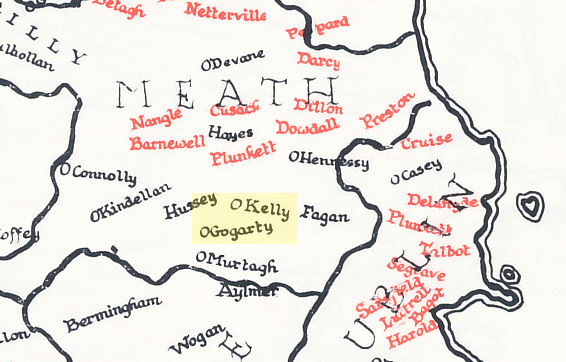 According to
Dr John O'Hart's
Irish Pedigrees the O'Kelleys of Co Meath which must
be the
O'Kelley of
Bregia used the same arms as their
cousins, the O'Fogartys. According to Irish Herald
Edward MacLysaght's book "More Irish
Families" the O'Fogartys in Co Meath
were the O'Gogartys and we can see
them from the map provided by
MacLysaght right next to the
O'Kelley of
Bregia. The O'Fogarty Arms uses symbols that one would expect
to find associated with "The Great Plain of Ireland" and
those claiming to descend from Irish Monarchs. The
English created the "Chief
of Arms" in 1552 to regulate the Irish Coat of Arms
under English law but
before that time the Irish had their own Officer of Arms
established in 1382
so this was once regulated under Irish Law but it is
likely the Gaelic Chiefs did as they pleased with their
Arms well before this time after all the
Book of Kells, one of the most illustrated books to
exist was created in 800 AD in Kells, Co Meath Ireland so
the Irish have a long history finding value and beauty in
art and images, we see this in the many carved stones left
behind so leaving their mark behind was well practiced. According to
Dr John O'Hart's
Irish Pedigrees the O'Kelleys of Co Meath which must
be the
O'Kelley of
Bregia used the same arms as their
cousins, the O'Fogartys. According to Irish Herald
Edward MacLysaght's book "More Irish
Families" the O'Fogartys in Co Meath
were the O'Gogartys and we can see
them from the map provided by
MacLysaght right next to the
O'Kelley of
Bregia. The O'Fogarty Arms uses symbols that one would expect
to find associated with "The Great Plain of Ireland" and
those claiming to descend from Irish Monarchs. The
English created the "Chief
of Arms" in 1552 to regulate the Irish Coat of Arms
under English law but
before that time the Irish had their own Officer of Arms
established in 1382
so this was once regulated under Irish Law but it is
likely the Gaelic Chiefs did as they pleased with their
Arms well before this time after all the
Book of Kells, one of the most illustrated books to
exist was created in 800 AD in Kells, Co Meath Ireland so
the Irish have a long history finding value and beauty in
art and images, we see this in the many carved stones left
behind so leaving their mark behind was well practiced.
Bregia" or Brey as it
was pronounced was a word used to describe the great plain
that extended North, West, and South of the City of Dublin
and it was a place where oats, barley, and wheat were grown
in abundance and the
O'Kelley of
Bregia Arms includes a
garb of barley between two lions ramparts. The Irish
Harp appears as a
charge and it's first recorded use was in the 12th
century by an Irish Monarch. The Irish Harp is
also used as a symbol for the Province of Leinster. Any Coat of Arms using the Harp would
indicate it had some tie to Ireland as a whole or the
Province of Leinster,
or the Irish Monarchs which is likely why the Fogartys used
it, like the O'Kelley of Bregia they claim descend from the Irish Monarch Aedh
Slaine. The Harp was the symbol for Ireland that King Henry
VIII added to his arms. The Crescent Moon is also
ancient and it can represent many things. I also
believe that because both the O'Kelley of Bregia and the
O'Kelly of Hy-Many use a blue shield and two Rampart Lions on
both Arms indicates there is a lost meaning to why there are
"two" lions and not one, and I wonder if that lost
meaning could be one lion represents The O'Kelley of
Bregia in the east and the O'Kelly of Hy-Many in the
west. Everything on an arms has a meaning so two lion's
verses one means something.
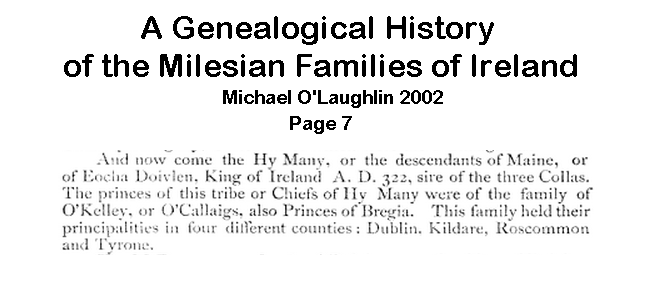 Noted
Irish researcher Michael O'Laughlin of the
Irishrootscafe.com published in 2002
"A
Genealogical History of the Milesian Families of Ireland "
and on page 7 he connects the O'Kelly
of Connaught and
the O'Kelley
of Bregia as
a single O'Kelley of Ui Maine Sept and suggests that "Chief of Hy-Many"
came from both lines and he
references them using the double "e"
spelling of my name. At the
time O'Laughlin published his book
in 2002 this was through to be true
but DNA had proven beyond all doubts
that the O'Kelley of Bregia,
O'Kellys of Hy-Many, the McGuires,
the O'Higgins, and most of the
O'Neills did not come from Milesians
of Iberia, nor do we share a Y-DNA
connection with the mythical 3
Collas. One has to go back to
2500 BCE or to
R-DF13 to find the grandfather
that we share and Y-DNA matches to
ancient remains indicate that
grandfather likely lived in, near,
or around Yorkshire England.
The
O'Kelley of Bregia,
O'Kellys of Hy-Many, the
McGuires, the O'Higgins, and most of
the O'Neills must go back to another
250 years to
R-P312 to find the grandfather
we share with the O'Neills of Tyrone
and Y-DNA matches to ancient remains
suggest that they may have not gone
to England and may have arrived in
Ireland via Milesians of Iberia and
because they were the last family
standing in Ireland I suspect they
are the source for the 3 Collas and
Milesians of Iberia myth. You
can follow my Y-DNA investigation
at this link. I don't
fault Michael O'Laughlin that Y-DNA
is proving much of what he has
written wrong, he has used the
information given to him just like
the rest of us trying to do Irish
history.
Sadly he passed away in 2020 so
he will not get the opportunity to
make correction to his material. Noted
Irish researcher Michael O'Laughlin of the
Irishrootscafe.com published in 2002
"A
Genealogical History of the Milesian Families of Ireland "
and on page 7 he connects the O'Kelly
of Connaught and
the O'Kelley
of Bregia as
a single O'Kelley of Ui Maine Sept and suggests that "Chief of Hy-Many"
came from both lines and he
references them using the double "e"
spelling of my name. At the
time O'Laughlin published his book
in 2002 this was through to be true
but DNA had proven beyond all doubts
that the O'Kelley of Bregia,
O'Kellys of Hy-Many, the McGuires,
the O'Higgins, and most of the
O'Neills did not come from Milesians
of Iberia, nor do we share a Y-DNA
connection with the mythical 3
Collas. One has to go back to
2500 BCE or to
R-DF13 to find the grandfather
that we share and Y-DNA matches to
ancient remains indicate that
grandfather likely lived in, near,
or around Yorkshire England.
The
O'Kelley of Bregia,
O'Kellys of Hy-Many, the
McGuires, the O'Higgins, and most of
the O'Neills must go back to another
250 years to
R-P312 to find the grandfather
we share with the O'Neills of Tyrone
and Y-DNA matches to ancient remains
suggest that they may have not gone
to England and may have arrived in
Ireland via Milesians of Iberia and
because they were the last family
standing in Ireland I suspect they
are the source for the 3 Collas and
Milesians of Iberia myth. You
can follow my Y-DNA investigation
at this link. I don't
fault Michael O'Laughlin that Y-DNA
is proving much of what he has
written wrong, he has used the
information given to him just like
the rest of us trying to do Irish
history.
Sadly he passed away in 2020 so
he will not get the opportunity to
make correction to his material.
As for the claim that the
O'Kellys of Hy-Many and the
O'Kelley of Bregia interacted, I
find nothing in "The Annals of
Clonmacnoise" that supports such a
claim. My research indicated
that these two families lived in
different worlds. The
O'Kelley of Bregia were part of
a much larger family that surrounded
and defend Tara in order to secure
their inheritance to be the High
Kings of Ireland not any different
than any other monarchy in the
world. It was their inherited
right to become High Kings and the
O'Laughlins, O'Kelleys, O'Reagans,
O'Connolys and the R-DF13->FGC11134>
R-FGC12055> Southern O'Neills were
part of these Royal Families of
Ireland who defended Tara and its
Royal Families. The
O'Kellys of Hy-Many were
regional kings that control only Hy-Many
and John O'Dugan the historian for
the O'Kellys of Hy-Many wrote in his
poem in 1392 AD about these families including the O'Kelleys of Tara. Dr John O'Donovan would
translate and publish these poems
and add his own notes about the O'Kelley
of Bregia
pronounced "Brey" which includes a description of
boundaries of Bregia.
Brian Boru was not part of the Irish
Royal Families and he sought to
change that gaining the support of
the Danish Ships and Armies to
defeat one Irish Chief after another
take hostages and demanding their
loyalty to him. When he became
powerful enough on page 165 of the
"The Annals of Clonmacnoise" it
states he and his Danish Armies went
to Bregia and "Slew them all", and
he stayed in Bregia for a while,
then withdrew to Munster for 3 years
then returned to Tara with his
Danish Army and forced the High King
of Ireland to surrender and some say
Boru declared himself "Emperor of
Ireland". When Boru met the
foreign Danes at Clontarf, the
Bregia survivors of his slaugher,
the McNeil's of Ulster and most of
Connaught except Ferall o'Roich and
o'Ferall"were not with him, Teige
O'Kelly of Hy-Many was there another
indicator that the
O'Kellys of Hy-Many and the
O'Kelley of Bregia were not
friends. After Boru's death
the old High King was restored as
was the old order of Kingship.
As for the
O'Kellys of Hy-Many arms it is
theirs and I suspect it was created
Maeleachlainn and he may have used elements of the O'Kelley of Bregia Arms by replacing the Garb of
Barley with a Stone Tower House and adding chains to the
Rampart Lions and putting the creature from the Enfield
on top to create the Arms that is widely
associated with all O'Kellys world wide today. You
might notice the Rampart Lions in
the Bregia Arms are not chained
indicting the Bregia Arms may have
been in use before the Norman
Invasion when the Irish ruled
Ireland.
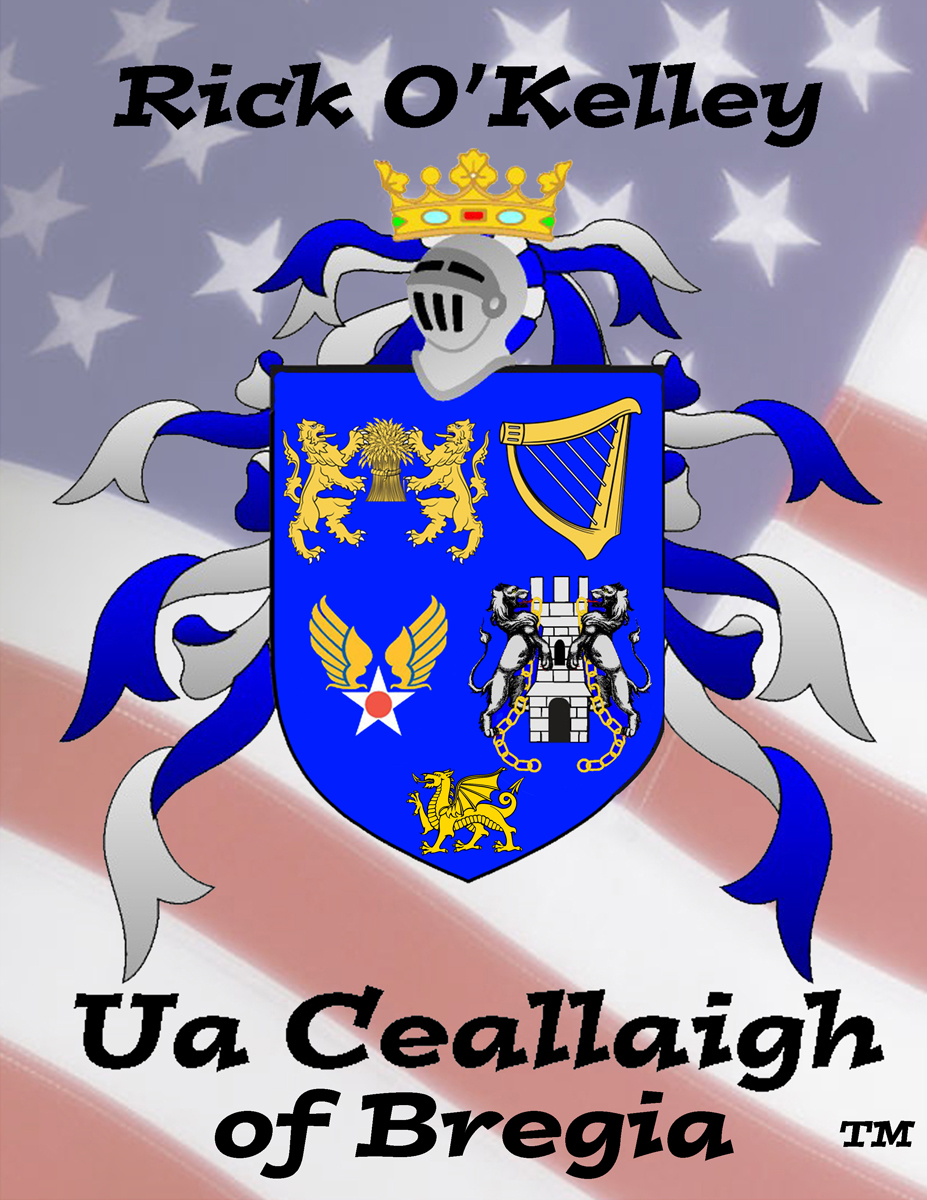
Personal Arms of Rick O'Kelley
-
In America we call "Arms" "Great Seals" but they are
the same thing and anyone can use
a
personal
arms to represent themselves as long as it doesn't
infringe on any registered trademarks so I fashioned a coat
of arms
for my personal use. I use an American Flag to represent my
service to my country during war time, I top my arms
with a crown to represent my descent from the Irish
Monarch Aed Slaine, the helmet represents the military
service of three of my grandfathers and my own father,
the left upper quarter of my shield displays the
O'Kelley of Bregia Arms, the right upper quarter
displays the Harp of Ireland the place my ancestors
lived maybe for more than 2000 years, the below left
quarter displays the Hap Arnold US Air Force emblem to
represent my service in the US Air Force Strategic Air
Command, and in the bottom right quarter I display the traditional
O'Kelly of
Connaught Ireland Arms because it
has been associated with my family for more than 100
years and I suspect it likely there were many marriages
between the O'Kelleys of Bregia and the O'Kelly of Hy-Many
as the Annals of Four Masters say they were equal in
power and wealth which is my basis for my theory that the reason
the two arms display Rampart Lions, one on the left and
the other on the right might be to represent the O'Kelly
of Hy-Many who descent from Maine Mor on the west of Ireland and the
O'Kelley of Bregia who descend from
Aed of
Slaine on the east. DNA indicates that one
would need to go back 5000 years to find the ancestor
that these two lines of O'Kelley share and that was 4000
before surnames were invented but I have come to believe
the O'Kelley surname had more to do with a nation than a
bloodline.
I was born in the
Year of the Dragon.
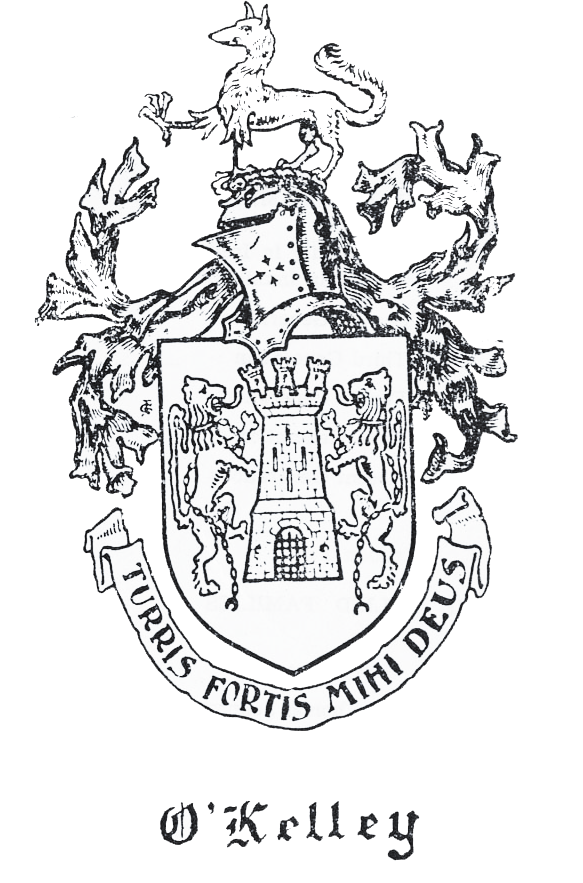
There is reason to assume that
Macon obtained the image from the
Francis O'Kelley branch of the
family, in her book she thanked Kate Walker (Effie
Kate O'Kelley) and Kate was the daughter of
Thomas Dean O'Kelley who as a
young college graduated traveled Europe including Ireland
with a college professor and he made that
visit in 1883 and in that time
Charles O'Kelly Esq of
Newtown in Co Galway Ireland used a registered Coat of Arms where
the Enfield is describes in
Bernard Burke's book as
Passant. Burke also describes the registered arms
of other native Irish O'Kellys and most all are described as
the large colored arms
where the Enfield is "statant".
A minor detail but cases are often solved because of the
discovery of a minor detail.
Thomas Dean O'Kelley Professr as he made education
his career, he may have been an artist and he
may have created the arms that Macon used or just
bought it off the streets of Ireland and came back with it
but his son,
Fredrick Henry O'Kelley was an
artist and the colored arms to the right is a photograph of an arms
that
Fredrick Henry O'Kelley painted,
framed, and gave as gifts to his family
members. I think this is evidence that Macon obtained
her Arms from this family. I received the photo
of one of his paintings from
Sandra Claire Thompson the
granddaughter of
Fredrick
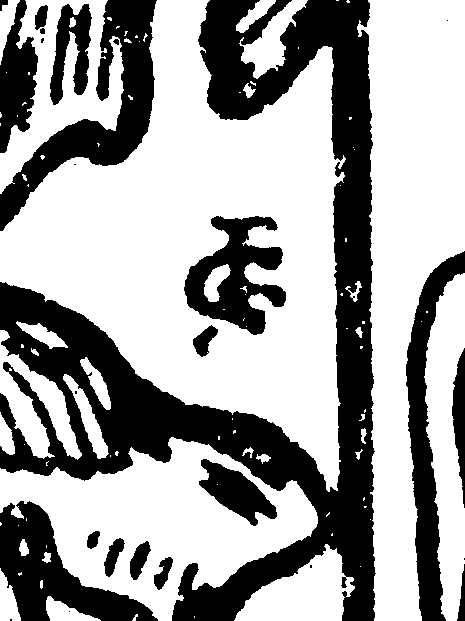 Henry
O'Kelley. I have no method to know but maybe
Alethea Jane
Macon's source for the Coat of Arms she used in her book
knew something that connected the Coat of Arms to my family
and has been lost but let me be clear,
Bernard Burke
does describe the arms that Macon used in her book very much
like the
arms of
Charles Kelly of Newtown but
is not of my family> I wonder if because
because the name
Charles O'Kelley runs deep in my American family if some
assumptions were made but DNA,
pedigrees, and my intense four year investigation exclude any possibility that we could be
of the family of
Charles O'Kelly Esq of
Newtown in Co Galway Ireland. And
while I do not know who may have created the Coat of Arms image
that Macon uses in her book, there is a
tiny mark that appears hidden in the Coat of Arms that I believe
may be the mark of the artist who
created this arms and if this mark can be identified the
true origins of this image can be proven. The
Kelly Clan of Ireland website uses a colored version of
this arms. Henry
O'Kelley. I have no method to know but maybe
Alethea Jane
Macon's source for the Coat of Arms she used in her book
knew something that connected the Coat of Arms to my family
and has been lost but let me be clear,
Bernard Burke
does describe the arms that Macon used in her book very much
like the
arms of
Charles Kelly of Newtown but
is not of my family> I wonder if because
because the name
Charles O'Kelley runs deep in my American family if some
assumptions were made but DNA,
pedigrees, and my intense four year investigation exclude any possibility that we could be
of the family of
Charles O'Kelly Esq of
Newtown in Co Galway Ireland. And
while I do not know who may have created the Coat of Arms image
that Macon uses in her book, there is a
tiny mark that appears hidden in the Coat of Arms that I believe
may be the mark of the artist who
created this arms and if this mark can be identified the
true origins of this image can be proven. The
Kelly Clan of Ireland website uses a colored version of
this arms.
Alethea
Jane Macon in her book describes the O'Kelley Coat of
Arms as "blue shield upon which is depicted in
silver a tower, triple-turreted, supported on each side by a
silver lion, rampart. From the neck of each of the
lions hangs a golden chain descending between his legs.
The mantle is blue and silver". Rightly
or wrongly it is the Coat of Arms most of my cousins believe
was used by our Irish ancestors.
|
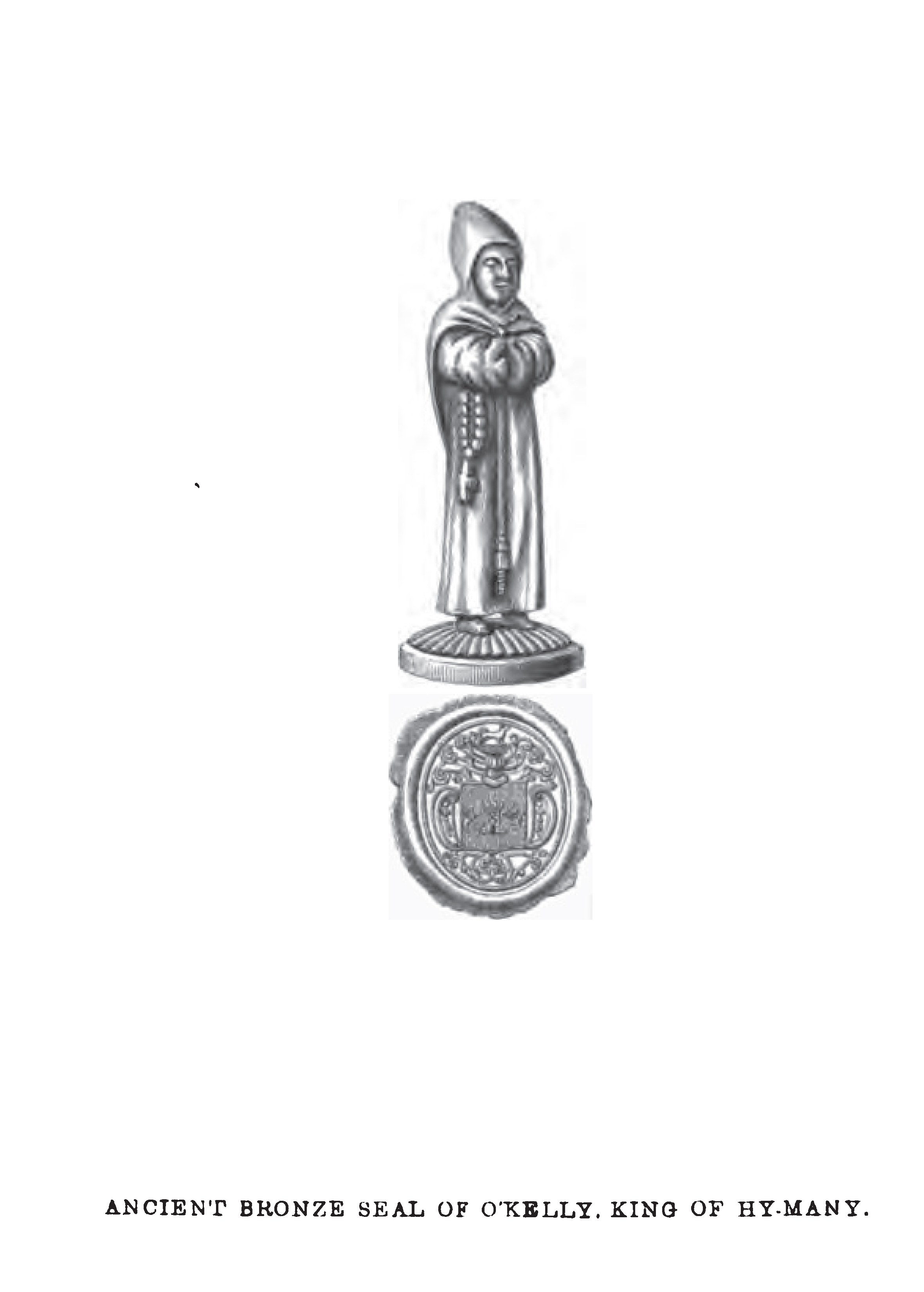
I have found only three physical examples for
the use of the O'Kelly Arms before 1750 and the
oldest is thought to be the
bronze stamp to the right. Since metals
cannot be carbon dated, I am not sure how the date
of this stamp could be determined but it was said to
have been discovered in a bog in Ireland in May of
1858 and while it is given as the seal of the
O'Kellys of Hy-Many I
can find no evidence that proves that this bronze
stamp was ever used by any O'Kelly and I have yet to
learn of any document
that survives today that bears the mark of this
seal? If one doesn't exist then I can't
discount the possibility that
this seal was created about 1858 for criminal
profit.
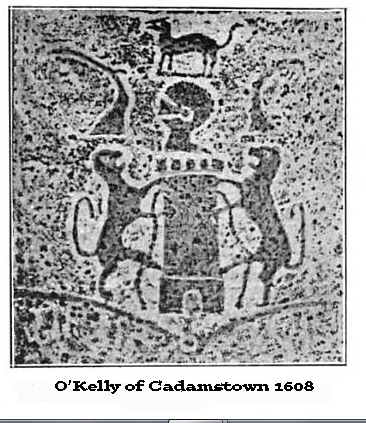
The arms that appears on the O'Kelly
Slab in the Cadamstown Churchyard
in Co Offlay was not far from Co Laois and it bears an
inscription that Coat of Arms was authorized by the
English
King of Arms St George in 1608 AD. The
stone bears the date of death as 1684 AD with an
inscription that translates "Here lies
Brian O'Kelly of Cadamstown, grandson of
Ferdinand O'Kelly, Lord of Irry-O'Kelly and
Carrig-Dunamas,
in Leinster, who led in marriage Ellenor, daughter
of Roger O'More of Balina, Esquire, by whom he had
six sons who were killed in battle, except Gerald
O'Kelly, a lieutenant of Charles O'More's regiment.
Gerald married Elizabeth, daughter of James Bagot of
Bathjordan in County Limerick, by his wife Sheelah
Poer; she was the grand-daughter of Earl of Muskerry,
and of Sir William Power of Kilbolan, Knight."
The full text is found in the
Journal of the County Kildare Archaeological
Society, Volume 2 By County Kildare Archaeological
Society beginning on page 448. On page 451
the author states this is the arms of the O'Kelly's
of Hy-many so it must have been issued in ignorance
but just because the descendants of the Hy-Many
began to register this arms as their own
after 1750 AD, that doesn't prove the arms
originated with them. I find it far more
possible that the O'Kellys in eastern Ireland, closer
to the English and the Pale might have used an English
Registered Arms well before the Hy-Many O'Kellys
in the west. This
arms on this slab includes a profile helmet, an
Enfield if it is an
Enfield as it looks more like a dog is "statant"
but may be "Passant"
as one front foot appears to not touch, lions with
chains, but the tower doesn't have the
traditional three turrets that one
finds in the arms claimed by the
O'Kellys of Hy-Many so this arms is
different but that difference appears to have been
missed by the authors. The
Cadamstown O'Kellys are thought not to
be descendants of
Tadhg Mór
Ó
Ceallaigh the ancestor of the
Connaught O'Kellys and Cadamstown is within
O'Kellie Country in Co Laois who were subchiefs to
the O'Mores and were of the
7 Septs of Leix who lost their lands through
confiscation in the 1500s and early 1600s.

The
Brian O'Kelly Cadamstown Coat of Arms appears
more like the modern descriptions of the
O'Kelly of Hy-Many Coat of
Arms than the oldest known example
and it comes in the form of a photo
from the
Kelly Clann of Ireland website where it is said
to be carved upon the tomb of
Colla O'Kelly the 7th Lord of Screen who died in
1615 AD and is buried in the
Kilconnell Abbey in Co Galway Ireland. I
think the image carved on Colla's tomb must be proof
that non related O'Kellys shared some common designs
in their Coat of Arms.
Colla O'Kelly a descendant of
William Boy O'Kelly was an O'Kelly
of Connaught or of Hy-Many, yet his arms looks different from the
description that appear in
John and Bernard Burkes books, different from
the Arms described in the 1800 books by
John O'Hart, and
John O'Donovan, and different from the Arms that
appears in
Edward MacLysaght books causing me to wonder,
who borrowed from who? I doubt anyone knows
when the image on Colla's tomb was carved but if it
was carved not long after Colla's death or even
before his may be the earliest image of what is
believed to be the "O'Kelly of Hy-Many"
arms and unlike the bronze seal and the
Cadamstown Arms, this carved image doesn't
include a helmet or crown, the Enfield also looks
more like a dog is "Passant"
and not "statant",
the chains are not represented, and it has the three
turrets common to the O'Kelly of Hy-Many
Arms. But this arms is different from the arms
associated with the O'Kelly of Hy-Many
as it has the traditional tower with the rampart
lions on each side that we all have come to accept
as the arms of O'Kelly it also has a third rampart
lion appearing on the far right and there are bars
or lines faintly represented behind the head of that
rampart lion. Colla O'Kelly's 1615 Coat of
Arms is very different from that of
Brian O'Kelly at
Cadamstown, the
Enfield on Colla's arms is standing upon the two
twisted cords called a "wreath" and it is over
and part of the third rampart lion and not over the
tower supported by two rampart lions. It seems
clear that as early as the time of Colla's death in
1615 different lines of O'Kelly had their own design
that may have been unique to their most powerful
ancestor but it appears most used some of the basic
elements found in the O'Kelly Arms today. I
know of no Irish O'Kelly Coat of Arms from any line
of Irish O'Kelly that does not use a
blue shield and two Rampart Lions.
|
| |
|
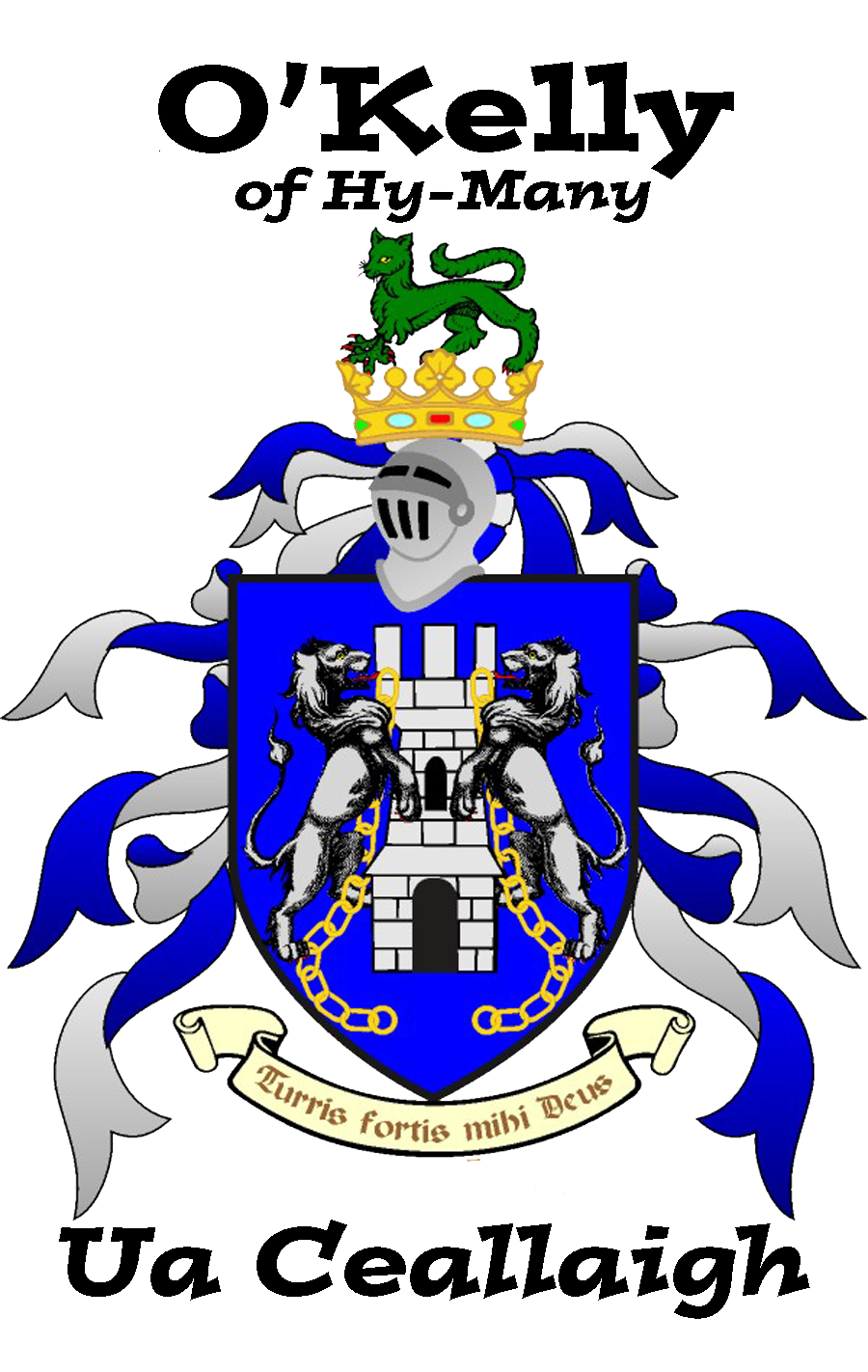
Bernard Burke describes: O’Kelley
of
Ui
Maine,
Ireland
Clann or Sept.
Arms:
Azure a tower triple-towered supported by two
lions rampart
argent as many chains descending from the
battlements between the lions’ legs.
Crest: On a ducal coronet or an
Enfield
vert**: Motto:
Irish: "Ta
Dia Dam Tor Laidir"
but
appears most often in
Latin: "Turris fortis mihi Deus" meaning
in
English
"God is my
tower of
Strength".
The Motto often appears as a banner below the
shield. Above the shield appears a
double
Coronet, the lower the helmet of a Champion*,
the upper a crown of nobility; the King of
Ui Maine. On top
appears a mythical
beast called an Enfield
describe as
vert or green and while there is a tradition
that is said the beast came from the Irish sea near
Dublin to stand over and protect the body of
Teige O'Kelly who fell in the
Battle of Clontart good Friday 1014 the use of
the Enfield is not unique to the Hy-Many O'Kellys as
the Enfield is a Heraldry Symbol
that denotes a chief
fell in battle. John O'Donovan reports that it
appears on several O'Kelly tombs in Ireland which
would suggest the person in those tombs were chiefs
who died in battle.
There are several distinctive
Coat of Arms some used by the descendants of
Teige O'Kelly but similar arms used by lines who
do not claim descent from
Teige O'Kelly.
Descriptions for numerous Hy-Many lines are
described by Burkes to appear mostly as
the large colored Coat of Arms to the left
or a
dual Coronet and the Enfield "statant" and it is
also the arms that we see below left for D H O'Kelly
but to the far right of D H Kelly's arms we see the
arms of
Authur Keily a family that lived mainly in South
and Southeastern Ireland who very early used the
double "e" spelling of O'Kelley. Sometime
during the reign of Queen Elizabeth they dropped the
"O" and became Kelley but during the reduction to
remove the unnecessary extra "e"s they became Keily
likely to set them apart from the Hy-Many O'Kellys
who began to use Kelly. The
Authur Keily Arms is not the only
variations on the most commonly accepted O'Kelly
Arms as Dr John O'Donovan one page 129 reports a
description for the Tycooly House in Co Galway
Ireland as field gules (red shield) and unchained
lions which is more like the below Arms for Castle
Kelly. The Coat of Arms to the right is the
arms for the O'Kellys of Barretstown Co Kildare as
described at the bottom of list in
Bernard Burke and the arms of the
O'Kelly of Ballysax arms also described in
Bernard Burke and these two Killdare
houses of O'Kelly are cousins both descend from the
House of Screen and
Colla O'Kelly.
Most all of these arms
present the Enfield standing on what appears to be a
stripped cushion. This is called a
"Wreath" which is two cords twisted and is said to
mean a "sign of authority". Why this appears
on some and not others is a mystery but nothing is
placed on a Coat of Arms without meaning and I note
that it is missing from the Coat of Arms that
appears in the front of
Alethea Jane Macon's book and it is
missing from the large color representation that
appears on the top left of this page. Why is
it missing, I suspect it is because the artist
overlooked it.
|
|
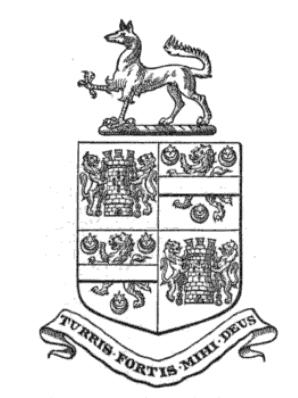
General
Richard Denis Kelly "The O'Kelly" of Mucklon Co
Galway Ireland used an arms that appears in the
Visitation of Ireland Volume 3 and it is very
different from all other O'Kelly arms.
English Coat of Arms were issued
to individual family members and only they can bear
the Arms, the Irish Coat of Arms belong to the Sept
and any blood descendent of that O’Kelley Sept was
authorized to display the Arms as his own but during
the 19th century when the Irish were becoming more
acceptable of English ways and customs several
different lines of O'Kellys made application and
were registered by
the
Ulster King of Arms. These O'Kellys appear
in Benard Burkes 1884 book titled "The
General Armory of England, Scotland, Ireland, and
Wales". Today they would make application
to the
Office of the Chief of Herold. The O'Kelly
Coat of Arms first appeared in the
Ulster Kings of Arms 1755 when registered by
Denis O'Kelly.
I think it worthy to mention that
I have displayed ten Coat of Arms that were actually
used, eleven if we count the Arms of Barretstown and
Ballysax individually for each house and the chains
that are commonly described in
Burkes appear only in the
Brian O'Kelly of Cadamstown, the Arms that
appears in the front
Alethea Jane Macon's book, the
Bookplate for D H Kelly, and the Arms of General
Richard Denis Kelly. Less than 50% of the
time the chains appear in real Coat of Arms.
The helmet appears in only the
Brian O'Kelly of Cadamstown, the Bronze Seal,
Bookplate for D H Kelly, and
Alethea Jane Macon's book and that too is less
than 50% of the Arms. Of the eleven arms
represented on this page, seven are used by
Colla O'Kelly of Screen and his descendants.
General
Richard Denis Kelly is said to have descended
from
William Boy O'Kelly but by
Hugh O'Kelly the 27th Chief of Hy-Many.
Brian O'Kelly of Cadamstown,
Fitz Roy Kelly, and
Authur Keily are thought not to have descended
from
William Boy O'Kelly but it is unknown if they
claim descent from
Tadhg Mór
Ó
Ceallaigh who died in 1014 at the Battle of
Clontarf.
|
|
|
O'Kelly Bookplates
from the 19th Century |
| |
|
|
|
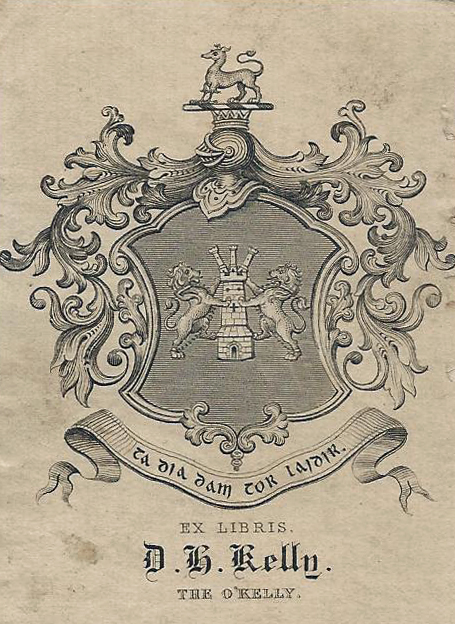 |
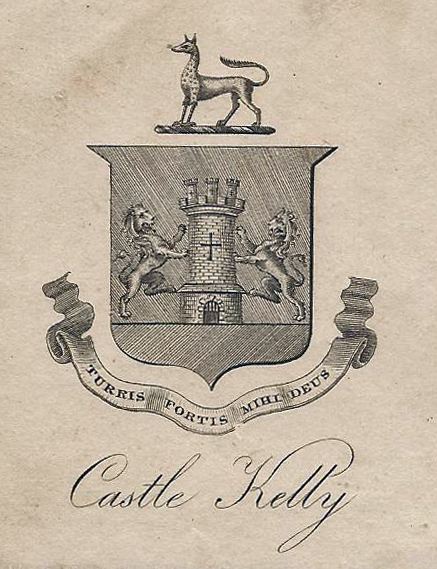 |
 |
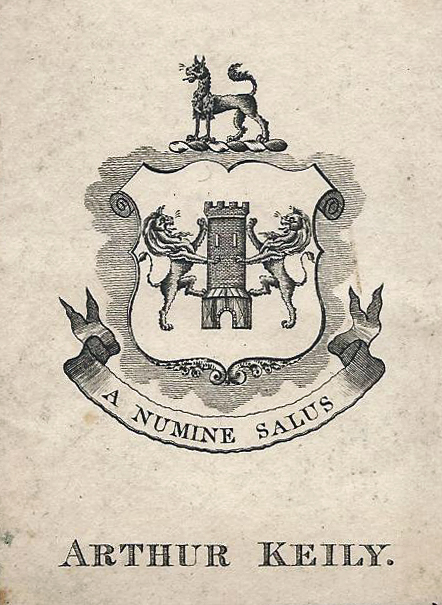 |
|
Denis Henry Kelly |
Rev Andrew Kelly
father of
Denis Henry Kelly |
Fitz Roy Kelly |
Authur Keily |
| |
|
|
|
|
Before Public Libraries, the
lords of the manors maintained their own personal
libraries and as they would loan books they needed a
method that would allow the ownership of the books
to be identified and this was accomplished by the
use of bookplates which were small labels often 9X6
CM that were pasted either in the front or back of
the book. The above are bookplates that I have
obtained. The first two are bookplates from
the O'Kellys of Hy-Many.
Castle Kelly was originally known as the Castle of
Aughrane. The second two are descendants of
other O'Kelly lines who like
Brian O'Kelly of
Cadamstown are thought not to have descended
from the O'Kellys of Hy-Many.
All four bookplates are dated to the 19th Century.
Notice the shields have direction lines, these tell
the viewer the color of the shield, it is called
Hatching, and only D H Kelly and Fitz Roy Kelly
are Blue, Castle Kelly has a green upper and a
purple lower while Authur Keily is white.
Some of the O'Kelly Coat of Aarms
include chains running from the Lions' neck down
between their legs but the Castle Kelly arms is
missing the chains and the dual
Coronet. The O'Kellys that descend from
Teige who died at Clontarf or the Battle of Brian as
most often given top their arms with an Enfield a
commonly used symbol that indicates the owner of
that Coat of Arms died in battle but the arms of
Fitz Roy Kelly is topped by a grey hound (Courage,
vigilance, and loyalty). Arthor Keily uses an
arms that is topped by an Enfield so like Teige that
indicates his ancestor fell in battle otherwise his
arms is like Castle Kelly's arms as it is also minus
the chains and his castle has four turrets while it
is said the O'Kellys have three so it appears there
were a lot of borrowing that occurred. These
minor differences might seem meaningless to us today
but they had meaning to those who bore those arms.
|
|